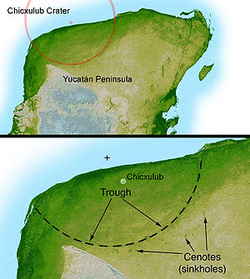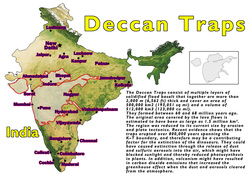
If there is anything more exciting and terrifying for kids to read about than dinosaurs, it is for them to read about large asteroids crashing into the Earth's surface and erupting volcanoes spewing out massive amounts of lava. In the early 1990's a huge crater was discovered on the coast of Mexico's Yucatan peninsula. Earth scientists determined that it was made when an asteroid crashed into Earth's surface at the end of the Cretaceous period.The crater that the asteroid made was dubbed Chicxulub, the name of a nearby town. The asteroid impact was blamed for the mass extinction of the dinosaurs approximately 65 million years ago. But geologists such as Greta Keller of Princeton suggest that the asteroid impact occurred approximately 300,000 years before extinction of the dinosaurs and therefore could not have caused their demise. These scientists also maintain that other similar impacts occurred before the boundary of the Cretaceous-Tertiary period extinction known as K-T and that it was rather the huge and violent volcanic eruptions that spewed out of the Deccan Traps found in modern-day India that finished them off. The Deccan Traps, named for a step-like rock formation, covered about 580,000 square miles between 63 to 67 million years ago when volcanic ejections hurled up to 10,000 billion tons of sulfuric dioxide into Earth's atmosphere, an amount of poison that circled the Earth suspended in the air in amounts that dinosaurs could not tolerate. In contrast Earth scientists state that the asteroid impact known as Chicxulub ejected between 50 to 500 billion tons of sulfur dioxide into the air. According to geophysicist Vincent Courtillot of the University of Paris, the Deccan volcanism began "just before the K-T boundary." Greta Keller agrees, stating that after the first flows of lava, "the species disappear; we have essentially very few left." The lava eruptions continued with two subsequent flows that prevented recovery of the species, and "by the fourth flow, the extinction is complete." The eruptions may have lasted for fewer than 30,000 years, actually a long time in human terms but not in geological history.

The extinction of about 70% of all life on Earth occurred at the same time that the dinosaurs were annihilated, but 30% of Earth life still remained. Although the age of the dinosaurs was over, the age of the mammals began. Let's not forget that there were also animals similar to dinosaurs such as alligators and crocodiles that survived the massive extinction, and it is generally assumed today that birds probably evolved from dinosaurs. It is possible that the volcanic activity of the Deccan Traps and the impacts of asteroids contributed to the massive extinctions of the K-T period.
 RSS Feed
RSS Feed